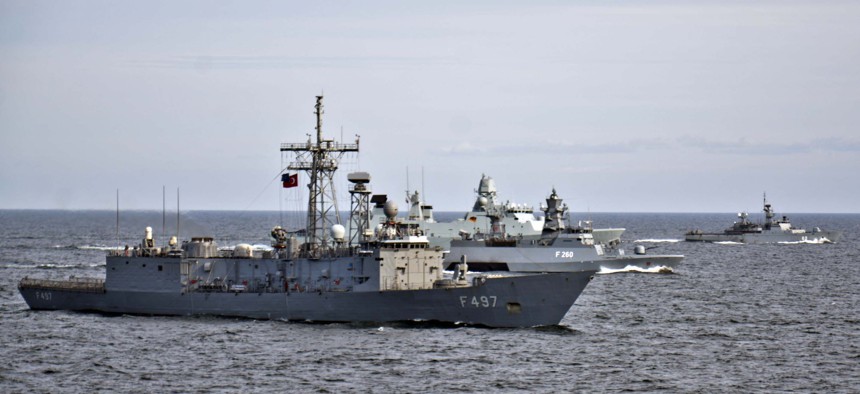
Allied and partner nation ships participate in close-quarters ship maneuvering drills during exercise Baltic Operations (BALTOPS) 2015. U.S. Navy / Mass Communication Specialist 2nd Class Amanda S. Kitchner
Fill the Cracks in NATO's Maritime Strategy
If Russia decides to attack the Western alliance, it would do so along several fissures that need shoring up.
What if Russia decides to deal with internal political and economic problems by attacking NATO’s Baltic member states? Most of NATO’s efforts to ensure the security of its most vulnerable Eastern European territories center on direct defense. However, given the manner in which a conflict is likely to unfold, addressing the maritime dimension is vital.
My recent report out from the Human Security Centre, Fire and Ice: A New Maritime Strategy For NATO’s Northern Flank, looks at the regeneration of Russia’s military, the priorities and doctrine of Moscow’s forces, the challenge it poses to the alliance, and the potential role of NATO’s northern maritime region in deterring and – if necessary – combating this threat. The analysis is framed in the historical context of the alliance’s 1981 Concept of Maritime Operations and the linked U.S. Maritime Strategy, with a view to determining what these approaches have to teach about managing the modern threat.
We started with a scenario in which Russia opts to externalize near-future internal political and economic problems via an attack on the Baltic region. The difficulties facing alliance forces in Estonia, Latvia and Lithuania are well known, and we assumed that NATO would lose most, if not all, of the territory of these three states before adequate allied mobilization can occur. So the allies’ next move would be to prepare for a major counteroffensive in Eastern Europe. In turn, Russia’s leadership — keenly aware of their inability to confront a fully prepared NATO on equal terms in the region — would seek to deter major offensive action and reach a favorable diplomatic settlement. Failing this, Moscow would focus its relatively limited forces on the alliance’s own military weak points, and this is where our analysis truly begins.
There are three key maritime factors to a NATO counteroffensive in Eastern Europe. First, the alliance has no realistic prospect of launching a successful ground operation without shipping substantial forces from the United States. It is unlikely that Russian forces could sever NATO’s Atlantic sea lines of communication. But by the mid-2020s, the Yasen-class nuclear-powered attack submarines and other new and upgraded vessels will provide a modest but potent force capable of inflicting militarily and politically meaningful losses.
Secondly, the Kremlin would be aware of the military, economic, and political vulnerability of Western Europe (in particular) to precision-guided long-range munitions. Moscow has long appreciated the potential of such weapons, but has only recently attained such capabilities in the form of systems such as the ship- and submarine-launched Kalibr 3M-14 and the air-launched Kh-101 land-attack cruise missiles. Such missiles would most effectively be employed by air and naval assets operating from the Arctic. The Northern Fleet will soon possess the most substantial share of Russia’s Kalibr-firing platforms, and bombers launching stand-off weapons in the area north of the Greenland-Iceland-UK (GIUK) Gap would be able to bypass NATO’s Eastern and Central European air defense systems.
Finally, Russia recognizes the vulnerability of its own northern maritime approaches. To counter this, Moscow has put substantial effort into redeveloping its military presence in the Arctic: opening new and refurbished airfields, adding surface-to-air missile and radar sites, and fielding the Tu-22M3-carried Kh-32 anti-ship missile — whose priority targets would be NATO vessels approaching the Russian coast.
In the face of these factors, NATO planners would do well to dust off lessons from the late Cold War. During the 1980s, the alliance mounted the Anti-Submarine Warfare Striking Force – a naval formation built upon at least one UK Invincible-class light aircraft carrier to help keep Soviet subs from passing through the GIUK Gap and attacking allied convoys. Today, the Royal Navy’s Queen Elizabeth-class vessels will soon be able to reassume the role, lifting a burden from the strained U.S. carrier fleet. Similarly, U.S. and British attack subs could be sent to the Barents Sea to intercept Northern Fleet submarines as they depart their bases.
The challenge of Russia’s precision-guided long-range conventional missiles lacks an exact Cold War parallel, but countering them on the northern maritime flank would require a U.S. Navy-led securing of the Norwegian Sea that would be familiar to any student of 1980s naval strategy. This would be necessary both to disable launch platforms, and to establish an air-defense zone to bring down at least some of the Russian missiles that make it aloft.
Finally, the U.S. Maritime Strategy in particular sought to exploit the vulnerability of Russia’s northern approaches. Although controversial, there was logic to going on the offensive against Soviet strategic assets such as ballistic missile submarines, and even targeting sites in the U.S.S.R. itself. In the modern context, such a path would force Moscow to divert elements of its relatively shallow pool of forces to defend its northern region rather than focus on the main theatre. Every missile battery, aircraft, and soldier sent to the Kola Peninsula and wider Russian Arctic would be one less to face NATO in Eastern Europe.
None of the approaches our report explores should be treated lightly. The eruption of open conflict between NATO members and Russia itself presupposes a number of major policy failures, and carries all the implied risk of hostilities between nuclear powers. But publicly planning and rehearsing for such contingencies may help deter a confrontation in the first place.
Related podcast:



